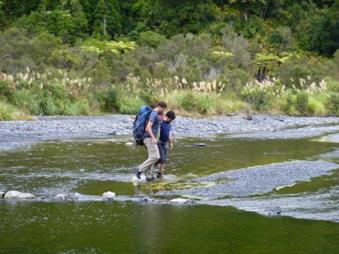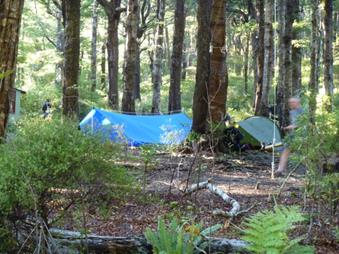The morning of Saturday 9th March dawned colder and wetter than had been predicted by both Amanda and the Meteorologists so I was glad I had packed a raincoat. From the house it was clear to see that it would be wet over in the Rimutaka ranges. Perfect conditions for an NZ bush-craft course.
Seeing that I had missed the entire preliminary bush craft briefing a few days before due to a miscommunication of start times, I arrived at the Wellington railway station a little earlier than the scheduled time of 0800. Amanda immediately impressed everyone with her ability to remember names and put them to early morning faces.
It was clear the group was international in flavour. The first give away were the non-short wearers, the second, their names and accents. We had Javier from Argentina, Chris from The Philippines, Ilske from Holland, Doug and Adam both from England, Richard a recent returnee from Australia and myself -a half Dutch- fully keen NZ’er. The rest of the party were genuine New Zealanders, namely Tracey, Richard and Mike.
Stuffing the mini-van full of backpacks, we piled in and Amanda got us underway.
Conversation was limited during the 40 minute ride in and I am guessing the steady rain and the sight of a rather grey and subdued Wainuiomata were responsible.
We arrived in the Catchpool valley car park and de-bussed. It was raining steadily and people were soon donning wet weather gear. My raincoat, ex-German Bundeswehr issue, was probably not the best choice. Chris subtly told me that in the Philippines camouflage gear was not recommended hiking attire, and when I replied that I realised it wasn’t best practise for being seen in the mountains, he said the real reason was so as not to be mistaken (and shot) for an Islamic militant. Good advice I thought.
After we had geared up, Amanda collectively asked the group why we all liked tramping. The reasons varied from just getting away from the stress and confined work-space of the daily grind, to getting out into the NZ bush after 4 years of not doing so. One theme was common: it was just great to be outside and away from it all while enjoying the amazing scenery NZ had to offer.
Amanda split us up into different 3-4 person groups and each group headed off, staggered a few minutes apart, towards the Orongorongo River via the Catchpool valley track.
As tracks go, this one was extremely well maintained. You could have pushed a baby stroller along it without waking its cargo. Amanda was quick to point out that this track was in fact SO easy it would rate below the grade of easy on the tramping scale of difficulty.
Every kilometre or so we stopped to consult the map we had been asked to bring. We were then tasked to find our position on the map, using the terrain around us and the time we had been walking. Amanda would then see just how close or far we were by taking a GPS bearing. Lesson one of bushcraft – take a GPS! (…and a map and compass for back-up of course)
About 30 minutes in the rain stopped. Bridges which had been washed out by last year’s floods were pointed out, and another positional exercise carried out. The topographical maps showed us that not all landmarks were necessarily marked, and in the case of bridges – subject to rapid change.
We reached the entrance to the Orongorongo river valley at 12 noon, and parking up just below the bridge had lunch.
Chris impressed all by munching down on a MacDonald’s big-mac and fries combo, while Amanda offered round homemade Tararua biscuits. The secret to these apparently is a dash of mustard.
While lunch was being digested, the second serious lesson of bush-craft was taught – the river crossing. From the dry banks of the creek bed we listened to Amanda go through the basic rules of river crossings, the technique of linking up, and the importance of having a leader. The stick test was explained as was the importance of finding the right place to exit the river. Paramount in this section was the rule ‘ If in doubt – stay out’. Not crossing a river was the surest way of staying out of trouble and backing out of one, or even attempting a crossing, was done via a group consensus. Brown rocks were to be avoided as slip hazards and never ever take your boots off while crossing. All good tips for the uninitiated and points which were not lost on us as Amanda revealed that most fatalities in the NZ bush were drownings.
A short time later we had formed back into our same groups and ventured to cross the trickling stream which was the Orongorongo river. Drought conditions and the total fire-ban it brought meant the river was well below its normal level. Several linked crossings later, everyone’s boots were suitably soaked and we headed downstream towards Paua hut.
Arriving at the hut saw the group get a lesson in what to bring and what not to bring. Groundsheets/tea-candles/spare boot laces and the zip lock rubbish bag all left an impression on me. Cotton was rightly outlawed in the NZ bush and the tips of the experts were laid bare. Amanda again wowed everyone by revealing the weight of her pack and the relative luxurious inflatable pillow.
It was at this point that I heard Xavier mention that he didn’t bring a sleeping bag. I thought I had misheard and presumed he meant a sleeping mat. ‘No, no – I have mat’ was his reply. ‘I didn’t bring a sleeping bag. It was a conscious decision’. Disbelief was soon met with unbelievable hilarity as Xavier revealed the cost of a sleeping bag was deemed too much, especially since he had spent a small fortune buying the boots, pack, pillow and one square meals.
‘I will sleep in the hut, in my clothes. No problem’ was the plan of attack for the coming night.
After socks had been wrung out and snacks consumed we were told to put the packs back on and head off up Paua ridge in a K-bar location exercise. We were given grid references of the approximate location of the packages and split-up into groups to start the search. Armed with compasses and badly folded top maps we stumbled up the hill trying to work out approximately how far up the teeth-breaking goodies could be found. Thankfully, our ‘guides’ were forthcoming in the clues as it became clear that the moment you couldn’t locate your position on the map – the map became quickly irrelevant even if the exact location was clearly marked.
Packages found, we headed back down towards the hut. After revealing to those not acquainted to this NZ national treasure the tip of letting the K-bar sit in the sun to allow it to soften up, I was promptly told that even resting this on the actual surface of the sun wouldn’t help. Adam had a point.
Arriving at the hut we were given a course in how to set up flys, and those who wished could sleep under them. Not having a sleeping mat, and preferring the warmth of the hut, the decision was easily made.
Dinner, a mix of Soba noodles, cream and vegetables, was expertly cooked and quickly consumed. The surprise of the evening was a custard covered sponge cake affair. On dishes were Doug and Adam, the authors behind the well-lit fire and the slight smell of singed sock.
For those brave souls enjoying the evening under the stars, they missed out on several things: the cacophony of snoring (Amanda’s tip of ear plugs deserve a mention here) and the tropical conditions of the fire. The mice went about their business unnoticed and Javier did not require the emergency blanket offered by Tracey, seeing the night out without incident.
Morning started with a quick breakfast and a talk by Amanda about hypothermia and the importance of merino base layers. Luckily due to the general improvement of clothing cases of hypothermia were not as common as they once were, but despite this, the signs and potential treatments were discussed.
Following the breaking of camp, gathering of firewood and a general tidy-up, we wandered down to the river to start the map and compass work. The basics were explained by both Richard and Amanda with bearings and declination discussed. We were tasked to find our position on the map and take a bearing to Brown’s track across the river. In open country in daylight, the basics were easily mastered with Javier and Chris taking particular satisfaction in knowing which way to orient the map and following something as fundamental as a compass bearing. Doug and Adam in the meantime did everything possible to ensure dry feet were kept at all times.
Several bearings and shallow river crossings later we arrived back at the entrance to the track back to the car-park. The walk back was swift and warm, taking a brief break at the mid-way section to discuss tramping and the up and coming tramping club events. Again Amanda dispelled all myths that there would probably be no easier tramp than the one we had just completed.
All in all, it was a great overnight experience. The mix of people was great and I haven’t laughed so much with strangers for a while. Amanda showed herself to be a very capable and informative tutor and the tips and tricks shared by the other experienced members were gratefully received.
Big thanks to Craig McGregor and Pete Gent who gave up their Saturday to help with the small group exercises and provide some expert navigation and gear advice.


